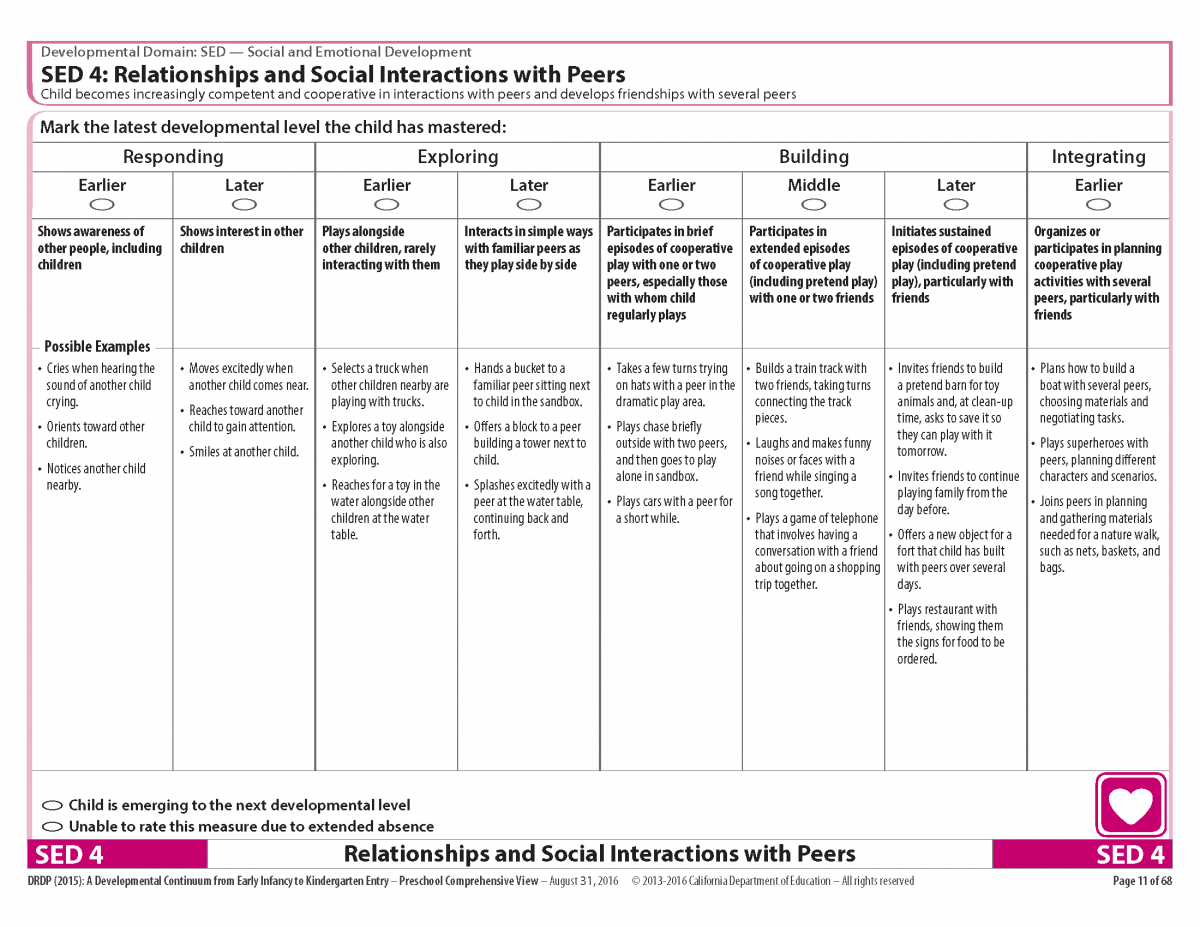Return to DRDP Measure Video Examples
Definition: Child becomes increasingly competent and cooperative in interactions with peers and develops friendships with several peers

View examples of the developmental levels for SED Measure 4 below: Responding Earlier, Responding Later, Exploring Earlier, Exploring Later, Building Earlier, Building Middle, Building Later, Integrating Earlier
Responding EarlierShows awareness of
other people, including children Possible Examples - Cries when hearing the sound of another child crying.
- Orients toward other children.
- Notices another child nearby.
| |
Responding LaterShows interest in other children Possible Examples - Moves excitedly when another child comes near.
- Reaches toward another child to gain attention.
- Smiles at another child.
| |
Exploring EarlierPlays alongside other children, rarely interacting with them Possible Examples - Selects a truck when other children nearby are playing with trucks.
- Explores a toy alongside another child who is also exploring.
- Reaches for a toy in the water alongside other children at the water table.
| |
Exploring LaterInteracts in simple ways with familiar peers as they play side by side Possible Examples - Hands a bucket to a familiar peer sitting next to child in the sandbox.
- Offers a block to a peer building a tower next to child.
- Splashes excitedly with a peer at the water table, continuing back and forth.
| |
Building EarlierParticipates in brief episodes of cooperative play with one or two peers, especially those with whom child regularly plays Possible Examples - Takes a few turns trying on hats with a peer in the dramatic play area.
- Plays chase briefly outside with two peers, and then goes to play alone in sandbox.
- Plays cars with a peer for a short while.
| Source: California Department of Social Services. 2016. |
Building
MiddleParticipates in extended episodes of cooperative play (including pretend play) with one or two friends Possible Examples - Builds a train track with two friends, taking turns connecting the track pieces.
- Laughs and makes funny noises or faces with a friend while singing a song together.
- Plays a game of telephone that involves having a conversation with a friend about going on a shopping trip together.
| Source: California Department of Social Services. 2016. |
Building LaterInitiates sustained
episodes of cooperative play (including pretend play), particularly with friends Possible Examples - Invites friends to build a pretend barn for toy animals and, at clean-up time, asks to save it so they can play with it tomorrow.
- Invites friends to continue playing family from the day before.
- Offers a new object for a fort that child has built with peers over several days.
- Plays restaurant with friends, showing them the signs for food to be ordered.
| |
Integrating EarlierOrganizes or participates
in planning cooperative
play activities
with several peers,
particularly with friends Possible Examples - Plans how to build a boat with several peers, choosing materials and negotiating tasks.
- Plays superheroes with peers, planning different characters and scenarios.
- Joins peers in planning and gathering materials needed for a nature walk, such as nets, baskets, and bags.
| What would your example be? |
Return to DRDP Measure Video Examples
